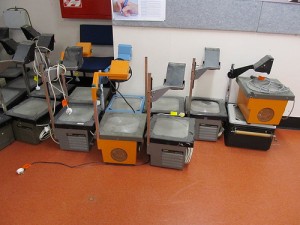Obsolete Printing Technologies: Transparencies –

By Janelle Sullivan

I always thought transparencies were the coolest things. Imagine printing something on a clear film and then being able to project the image on the wall for everyone to see. The overhead projector, with its light bulbs, mirrors and lenses was once considered the height of technology. Transparencies were used in classrooms as a way of sharing images or problems with an entire classroom full of students. Even major airlines, such as Boeing and Beechcraft, used transparencies to review designs with their engineers. But transparencies are joining a large group of obsolete printing technologies that are being replaced by more modern technologies.
Transparencies, used with an overhead projector could be created in a couple of different ways. The low tech version, often used in classrooms, involved using markers and drawing or writing the image directly on the clear, acetate sheet that would be projected. Colleges and many businesses might use a more high tech method that has a laser printer printing images from a computer. While laser printers are the most effective, toner printers can also print a transparency. With the advances being made in technology, transparencies are being used less and less.
Transparencies are still used by artists and illustrators to add dimension to their work. I remember, as a kid, my parents had a set of encyclopedias that I loved to look at. The section on the human body was my favorite. It had transparencies that could be peeled back to view the layers of the human body. It was awesome to start with the skin and as you lifted each layer you would see muscles, bones, the circulatory system and the internal organs. While this is just a small use for this technology, it was one that made an impression on me.
As digital projectors and Smart Boards are becoming more available and affordable, they are also becoming more widely used. Fewer steps are required to develop presentations and the equipment is more portable. Computers allow information to be shared, quickly and easily, and many projects do not require any hard copies to be made. This can cut down on the expense of sharing information. It is the speed and portability of many new technologies that add older versions to the graveyard of obsolete printing technologies.
Because Smart Boards allow projection of the desired images, much the same as a digital projector, they are interactive. The touch of a finger can allow the user to highlight important sections of text or even add to what is on the screen. Moving from screen to screen can also be accomplished by a finger or a stylus pen. This type of technology is becoming sought after in many educational institutions, and is widely accepted as a good way to spend technology money. As these newer, bigger, better technologies advance and become more affordable choices, I am sure we will see fewer and fewer uses of transparencies. I am all for advancement. I love technology but I still enjoy checking out the technologies that led to where we are today.
